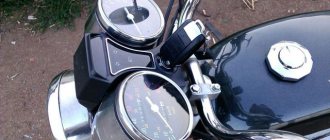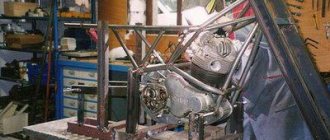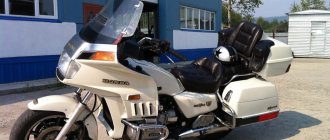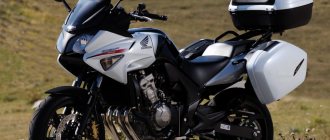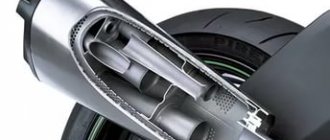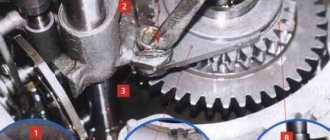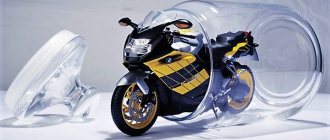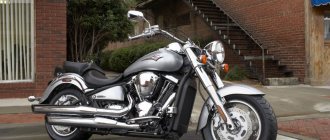Sometimes the motorcycle simply refuses to start when you turn the key - most often this happens when cold weather sets in or after a long period of parking. Beginners in such a situation often begin to panic, but experienced bikers first check the condition of the vehicle, and then use one of the backup methods of starting the engine. Everyone should know about them, since any equipment is prone to breakdowns and may refuse to start at the least opportune moment. Understanding how to start a motorcycle in an emergency will at least help you get to a specialized service center where you can repair your two-wheeled vehicle.
Preliminary diagnosis
Before using one of the methods for starting the engine in an unusual situation, you should check the serviceability of the motorcycle. The main thing is to check whether there is gasoline in the tank, since the fuel consumption of two-wheeled vehicles can vary greatly depending on the riding style and some bikers do not have time to monitor the availability of fuel. It is useless to look at the sensor, since it often malfunctions. The best way is to unscrew the tank cap and look inside to make sure there is fuel.
To start a motorcycle after a long period of inactivity, you need to make sure that fuel can reach the engine. The fuel system pipes must be in place, the carburetor caps must be closed, and the fuel tap must be open. The ignition must be turned on, since the engine will not be able to start without firing the spark plug. Also remember if there have been any symptoms of engine failure recently - strange knocking noises at high speeds, a sudden stop in fuel supply, and others.
Before starting the engine, perform one more small check:
- The footrest must be raised;
- The key is turned to the working position;
- Neutral gear must be selected.
If everything is normal, you can begin the procedure. Try not to lose control of the motorcycle while starting the engine, as this often leads to disastrous consequences.
002_MOTO_0210_062
Markers for the “middle” position of the steering wheel in the brackets of the upper yoke.
Instead of risks on some motorcycles - period. Markers for the “middle” position of the steering wheel in the brackets of the upper yoke. Instead of risks on some motorcycles - period.
Also make sure your fingers don't get caught between, say, the handlebars and the tank (though this is more common on road bikes). Check whether the throttle cable is stretched excessively in the extreme positions of the steering wheel and whether the handle returns freely. One of my friends shamefully decomposed in front of the visitors of a fashionable cafe because of a tight throttle cable. When turning, the cable itself “added the throttle”, and the surprised owner of a fashionable naked bike stretched out in the parking lot with a roar and a roar.
A little effort
The classic way to start the engine when there is no battery charge is with a pusher. It is used by bikers of all ages and nationalities as this method is effective for all manual transmission motorcycles. Unfortunately, the latest technology with semi-automatic and robotic transmissions cannot be started in this way - you can only damage its expensive components.
A motorcycle with a low compression ratio or with an engine capacity of up to 350 cubic centimeters can be started from a pushrod yourself. But modern Japanese sportbikes or choppers with huge engines will require a lot of effort - so you will have to find an assistant. If you are in a remote area where you cannot expect help, try to find a slope at least 100 meters long - this will make solving the problem much easier.
The motorcycle will need to be accelerated to approximately 10–12 km/h, that is, jogging speed. Before starting acceleration, squeeze the clutch lever and select second gear - starting in it is noticeably easier than in a lower gear. The only exceptions are Kawasaki motorcycles - their owners are recommended to engage first gear when starting from a pusher. When the desired speed is reached, carefully release the lever and wait for the corresponding sounds from the engine.
If the engine does not start, it is best to stop and rest for a few minutes before trying again. After four or five times, you should come to terms with the fact that your equipment is faulty and needs the help of a professional mechanic. If you succeed in starting the engine, you need to squeeze the clutch lever again so that the motorcycle does not drive away from you on its own. Stop and rev up - this will help stabilize the fuel supply and also recharge the battery, which will take about half an hour. If you are trying to start a motorcycle without a battery, you can go in search of a new battery after a couple of minutes, since there is not much point in long-term revving.
008_MOTO_0210_063
...and knurled nuts (along the length of the cable).
...and knurled nuts (along the length of the cable).
Remember: by adjusting the lever, you do not change the performance of the brake system in any way. All this adjustment allows is to move the lever further or closer to the steering wheel grip. People with long fingers move it further away. Those who have a smaller hand - for example, girls - choose the closest position of the lever. At the same time, on older motorcycles (especially with one brake disc and especially a drum), you need to make sure that in the close position the lever has enough travel left: squeeze it with force and make sure that it does not rest against the gas handle. If it gets stuck, you will have to move it away from the steering wheel. The situation can be corrected by bleeding the brakes or replacing the brake hoses with reinforced ones. I'm not talking about the cable drive - only replacing the motorcycle assembly will help here. By the way, to change the adjustment of the position of the lever, you must first slightly press it away from the steering wheel and only in this position rotate the regulator. Do not try to adjust the lever while moving, it is very dangerous!
If the clutch is a cable drive, all you can do is increase or decrease the free play of the lever by rotating the adjusting wheel at the end of the cable sheath.
The norm is a gap of 1–2 mm between the plane of the lever and the bracket. If with such a gap it is still difficult for you to reach the lever with your fingers, you can increase the free play. The main thing is that the lever travel is enough to fully depress the clutch: with the lever fully depressed and first gear engaged, the motorcycle should stand confidently in place without trying to move (the oil in the box must be warmed up).
To maintain full control of the motorcycle, it is better to depress the clutch with your middle and index fingers, and leave the rest on the handlebars. That is why a full squeeze should be considered not the moment when the lever rests on the steering wheel, but the position in which it touches the ring finger lying on the steering wheel handle. Precise clutch operation is very important for a motorcyclist, especially when maneuvering in traffic jams, turning on narrow streets, and crossing obstacles. Many motorcyclists, forgetting about this, try to achieve high traction at low speeds by changing gear ratios in the chain drive or even applying the rear brake when cutting through city traffic jams. I often hear complaints: “My sportbike jerks in second gear when I drive slowly in traffic, and in first it is too sharp. Do something about the engine." Instead, it is enough to skillfully use the potential of a properly adjusted clutch. By the way, a complete lack of free play on the clutch lever is unacceptable, as it can lead to rapid and fatal wear of the friction discs.
If the clutch drive is hydraulic, we adjust it in the same way as the brake. Free play in this case does not matter.
The free play of the throttle handle can also be adjusted. Many fans of fast driving believe that the less free play on the throttle, the more accurate the engine control.
Complex issue
Every motorcyclist can experience such a nuisance as losing the ignition key. It is very easy to solve such a problem using domestic technology. You need to take two nails and solder them together to get a T-shaped handle. The base should be flattened with a hammer or a vice to obtain a thin, wide plate. All that remains is to insert it into the lock to start the two-wheeled vehicle without a key.
However, the problem may not be the loss of the key, but the breakdown of the vehicle. It is necessary to completely remove the ignition switch and directly connect the wires responsible for starting the engine. Which ones exactly depend on the motorcycle model, year of manufacture, as well as the availability of tuning components. In order not to take risks over trifles, review the instructions for the motorcycle in advance and look through the pages of specialized forums on the Internet. Be careful - if you accidentally connect the wrong wires, you will have to change the fuse, which will probably blow.
It is also possible to start the vehicle using a kickstarter. You need to make sure that the wires responsible for the ignition are connected to each other, but do not touch the cable that is responsible for automatic starting. After this, the motorcycle starts with a strong blow to the kickstarter pedal - usually 3-5 attempts are enough to get results. However, this option is only suitable for small-capacity vehicles - on motorcycles with an engine capacity of more than 250 cubic centimeters, there is usually no kickstarter.
If you need to start without an ignition switch on modern technology, it is better to go straight to a specialized workshop, since you will have to deal with the electronic immobilizer. However, it is possible to start such a motorcycle, although you will need a special device - an immobilizer bypass. It is installed under the ignition switch or instead of it, depending on the model of the device and the motorcycle. The electronics are turned off, and your only task is to choose the right wires to connect.
005_MOTO_0210_063
On road motorcycles, the landing should be natural: the back is almost straight, the arms are slightly bent at the elbows and relaxed, the hands rest freely on the handlebars.
The seating position should not restrict the movement of the steering wheel—the outer handle should not be reached for, and the inner handle should not push or pinch your hand. If you cannot sit comfortably, try adjusting the position of the steering wheel. On road motorcycles, the landing should be natural: the back is almost straight, the arms are slightly bent at the elbows and relaxed, the hands rest freely on the handlebars. The seating position should not restrict the movement of the steering wheel—the outer handle should not be reached for, and the inner handle should not push or pinch your hand. If you cannot sit comfortably, try adjusting the position of the steering wheel.
As a rule, there is a mark on the steering wheel in the area of the attachment point, which, according to the designers, should coincide with the parting plane of the steering wheel bed covers. But if your hands are uncomfortable, you can turn the steering wheel slightly from the base position (away from or towards you). Remember that on the steering wheel covers you need to tighten the front bolts first (to the specified torque), and only then the rear ones. As a result, at the back, between the covers and the crossmember, a small but necessary gap is obtained. After adjustment, carefully turn the steering wheel from lock to lock. Make sure that in the new position it rotates freely and does not interfere with motorcycle parts.
Winter way
Not all owners of two-wheeled vehicles refuse to drive them in the cold season. However, starting an engine with a high compression ratio becomes a real pain at low ambient temperatures. Therefore, experienced motorcyclists advise using a method that has been proven for decades.
To understand how to properly start a motorcycle in winter, you need to choose the appropriate chemical. It is most often sold under the name “Starting Ether” or “Starting Fluid”. The liquid is supplied in spray cans, which make it easier to get it into the desired area of the fuel system. It should be applied directly to the surface of the filter element - it can be located next to the carburetor or under the motorcycle tank. It is not necessary to tighten all the bolts after the first attempt, since this may not be the only one.
After applying ether to the fuel filter, try to start it normally, using the starter, or by accelerating the motorcycle yourself and putting it in gear. To start the engine, you will need 2-3 attempts - if the engine does not show signs of life after the third time, it can be considered faulty with a 99% probability. Be very careful - you are allowed to use ether 1-2 times during the winter season, since its use accelerates engine wear several times. It is much better to pre-warm the motorcycle in a warm garage, starting it at normal fuel and metal components temperature.
If you need to start the motorcycle after a long period of inactivity, you should first drain the gasoline and wash the carburetors. On vehicles with electronic injection control, it is also recommended to clean the injectors, since they may contain remnants of a mixture that has long since become non-flammable. To prevent this from happening, before storing it, you should fill the tank with a special liquid, which is called a fuel stabilizer. Be extremely careful, since a regular bottle is enough for 1-3 full car tanks, and excessive concentration of such a chemical compound in fuel can lead to motorcycle engine damage. It is also worth removing the battery before winter storage, storing it in a warm place and recharging it every 2-3 weeks, so that later the motorcycle has enough charge to start the engine using the starter.
Why does a motorcyclist need to train his eyes?
Vision for a motorcyclist is the main and most reliable source of information about the environment. Correct work with the gaze when driving a motorcycle ensures
It is necessary to turn your head and look inside the turn to correctly calculate the trajectory
better use of vision and, as a result, increases the amount of useful information that the motorcyclist can handle to effectively control the motorcycle. Working with your gaze correctly requires a basic understanding of how our vision works.
Choosing the right method
You can start a motorcycle using various methods, but it is worth remembering that all of them, from starting at speed to using starting ether, harm the engine. If we talk about removing the ignition switch and independently connecting the wires to each other, then in this case there is a very high probability of a short circuit with dire consequences for electrical and electronics. Therefore, you should first find out if there are other options, for example, recharging the battery, taking a spare key, or contacting a specialized workshop. It is also not recommended to install various devices that bypass the motorcycle security system or move wires outside. If you can use them, then the motorcycle will be easily stolen by criminals who always target such easy prey.
Driving a motorcycle and using vision
Due to evolution, even an untrained person (and even more so a trained person) is capable of determining the distances and speeds of movement of various objects relative to himself with satisfactory (in the range of “civilian” conditions) accuracy. However, to do this, both eyes must be directed at the observed area. In other words, to get a good estimate of the distance and speed of movement, you can’t just squint your eyes, you need to turn your head and look in the direction of the observed area. Since the priority area of observation when driving a motorcycle is obviously its trajectory, most of the time the head and gaze should be directed precisely along the planned trajectory of movement. To be able to
When braking heavily in a straight line, the gaze is directed far in a straight line. Don't look at the obstacle
plan the trajectory in advance - you should look along the trajectory as far as possible. Typically, to effectively plan your movement, it is recommended to view the distance from one to twelve seconds.
011_MOTO_0210_064
You should be especially careful with a two-cable drive.
It’s better to leave a little play than to catch a runaway motorcycle one day. You should be especially careful with a two-cable drive. It’s better to leave a little play than to catch a runaway motorcycle one day.
Once you've adjusted the steering controls, it's worth a ride. Preferably at least half an hour. The body does not immediately find a comfortable position, and those settings that at first seemed comfortable need to be tested in practice. And if everything is fine with the upper limbs, you should turn your attention to the gearbox foot and the foot brake pedal.
I think motorcycle brake manufacturers should pay kickbacks to motorcycle shoe designers for thick welts on their boots. In my memory, how many rear pads have been worn out and brake discs burned because the next owner of size 45 shoes had a shoe resting peacefully not only on the footrest, but also on the brake pedal. The unsuspecting “teapot” drove, sometimes tens of kilometers, smoking with its rear brake pads, like that blonde with the handbrake. So, the following advice is especially useful for giants. When getting on the motorcycle, make sure that your right foot is not trying to press the brake. And if he tries, we try to lower the brake foot. Many motorcycles allow you to do this thanks to an adjustable link between the pedal and the brake cylinder.
020_MOTO_0210_066
Enduro should be comfortable to ride in a standing position.
In this case, there should be enough space to move the body forward (when accelerating and overcoming climbs) and backward (when braking and on descents). Enduro should be comfortable to ride in a standing position. In this case, there should be enough space to move the body forward (when accelerating and overcoming climbs) and backward (when braking and on descents).
It is not recommended to tighten the bracket clamps too much. After all, off-road you can easily fall or simply drop your motorcycle. A slightly tightened bracket will simply rotate around the steering wheel and the lever will not break! The brake pads and gearbox also need to be adjusted. After all, when you stand on the pegs in motocross boots, the toes look more horizontal, and not at an angle downward. But don't overdo it. The control test is simple - accelerate to a speed of 40 km/h while standing and try to lock the rear brake. If this was achieved without any extra effort, the presser foot is adjusted correctly.
Independent exercise No. 2
Removing the motorcycle from the stand Now we learn how to remove and put the motorcycle on the stand. Stand to the left of the motorcycle. With your left hand, grab the handlebars, and with your right hand, grab the handle on or near the saddle. Push the motorcycle forward until it jumps off the stand and onto its wheels. At the same time, be careful and careful. Having stood on its wheels, the motorcycle will immediately begin to fall on its side. When you push it off the stand, try to let the motorcycle lean slightly towards you - you will probably be able to hold it quite easily. But if the motorcycle starts to fall in the opposite direction from you, then you have practically no chance of holding it! Having held the motorcycle, we learn to put it on a stand. You may need to do this exercise several times until you can quickly and confidently remove, hold, and place it on the stand.
015_MOTO_0210_065
Some enduro bikes have adjustable pedals for different riding styles.
This adjustment is for riding in a standing position. Some enduro bikes have adjustable pedals for different riding styles. This adjustment is for riding in a standing position.
When adjusting the position of the gearbox lever, when shifting gears up, do not try to push the motorized boot completely under the paw - this is almost impossible. Just hook the paw with the welt of the boot, and the gear will change without difficulty.
016_MOTO_0210_065
With this adjustment, it is more convenient to ride while sitting.
With this adjustment, it is more convenient to ride while sitting.
Of course, it often happens that you immediately feel comfortable on a motorcycle. If so, great, but if something causes discomfort, even if it’s just the wrong time on the electronic clock, it’s better not to be lazy and eliminate the annoying factor in advance so that it doesn’t distract from the main thing - the pleasure of driving the most beautiful of all vehicles.
Closer to the body - adjusting the controls
017–018_MOTO_0210_065
Rear spring pretension adjuster: on the left - with a screw, on the right - with nuts on the shock absorber body.
When the motorcycle is heavily loaded, it is necessary to tighten the adjuster. If this is not done, the headlight beam will shine upward and blind oncoming traffic. Moreover, the motorcycle will handle worse, since the main load will fall on the rear axle. Rear spring pretension adjuster: on the left - with a screw, on the right - with nuts on the shock absorber body. When the motorcycle is heavily loaded, it is necessary to tighten the adjuster. If this is not done, the headlight beam will shine upward and blind oncoming traffic. Moreover, the motorcycle will handle worse, since the main load will fall on the rear axle.
So, if the headlight starts to shine into the sky, try adjusting the height of the rear of the motorcycle first. Perhaps the reason is not the headlight, but the large number of Big Macs eaten by the driver or passenger. In this case, by restoring the horizontal position of the motorcycle, you will bring into compliance not only the light adjustment, but also the suspension geometry. If adjusting the shock absorber was not enough, find a plastic adjuster on the headlight housing (as a rule, it looks like a large bolt) and twist it to achieve the desired result.
Independent exercise No. 4
Sliding downhill Having worked the previous exercise, move on to the next one. For this you will need to find a site with a slight slope. Sitting in the motorcycle seat, push off your feet from the ground and start moving downhill. If at the same time you feel that the motorcycle is starting to lean to the right or left, level it by turning the steering wheel in the appropriate direction. When driving the motorcycle downhill, use the handbrake to prevent the motorcycle from accelerating too much. Practice this exercise until you achieve the ability to confidently maintain your balance. For the next step of the exercise, ride down while standing on the left footrest of the motorcycle, and at the end of the incline, move your right leg over the saddle and sit in it. It is also necessary to learn how to accelerate the motorcycle and jump on it while moving. This may come in handy if the kickstarter is broken or the battery is dead. Having mastered this exercise and feeling that the motorcycle is completely obedient to you, we proceed to start the engine.
